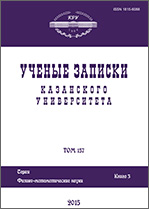|
|
Kazanskii Gosudarstvennyi Universitet. Uchenye Zapiski. Seriya Fiziko-Matematichaskie Nauki, 2009, Volume 151, Book 1, Pages 8–16
(Mi uzku713)
|
 |
|
 |
This article is cited in 1 scientific paper (total in 1 paper)
The XII International Youth Scientific School "The Coherent Optics and Optical Spectroscopy"
Analysis of IR Vibrational Spectra of Isomeric Butanediols in Inert and Proton Acceptor Solvents
D. I. Abaidullina, M. A. Varfolomeev, B. N. Solomonov
Kazan State University A. Butlerov Institute of Chemistry
Abstract:
Investigation of the aliphatic systems able to form intramolecular hydrogen bonds and intermolecular interactions in condensed media is a complex and actual question. The description of intermolecular interaction mechanisms could contribute to the solution of important problems, such as carbohydrate self-association mechanism investigation, molecular recognition and new substance synthesis. The carbohydrate identification with bio receptors occurs by lots of weak interaction (among them are H-bond and van der Waals interactions) formation. However, there are no methods allowing to analyze them separately.
IR-spectroscopy is one of the most universal methods for investigation of different types of non-covalent interactions. However, in order to obtain correct results, proper analysis methods should be developed and tested on simple objects.
The investigation of solvent effects on intra- and intermolecular hydrogen bonds in 1,2-, 2,3-, 1,3-, 1,4-butanediols and its complexes with proton acceptors was carried out in this work. Analogies and differences of intramolecular H-bond formation of studied diols by IR OH-stretching vibrations characteristics were analyzed. The solvent effect on IR frequencies of free and self-associated O–H-groups of studied alcohols was described.
It was shown that intramolecular H-bonds strength and stability depend on the size of cycle formed by intermolecular H-bonding and the OH-groups in butanediol molecule location. Linear dependency between cycle size and strength of intramolecular hydrogen bond in 1,2-, 1,3- and 1,4-butanediol was observed, except data for 2,3-butanediol. Stability of these hydrogen bonds in opposite side is changed. This fact was confirmed by relation of intensities of H-bonded and free O–H-groups. Analysis of solvent effects on frequencies of O–H-groups H-bonded with proton acceptors was carried out. It was shown that values of frequencies of intramolecularly H-bonded butanediols in aprotic solvents were described by solvent parameter $S_{VW}$ responsible for van der Waals interactions. In proton donor solvent, like chloroform, intramolecular hydrogen bonds are strengthened (about 30%) due to cooperative effects. It was found that structure and composition of butanediols H-bonded complexes depend on solvent proton acceptor affinity and the diol concentration. For strong proton acceptors, quantity of intramolecularly H-bonded O–H-groups decreases with increase of diol concentration. For weak bases the relation between these species is practically not influenced by diol concentration.
Keywords:
intramolecular hydrogen bond, IR-spectroscopy, butanediols, frequency, intensity, van der Waals interactions, proton acceptor ability, cooperative effects with diol concentration.
Received: 16.01.2009
Citation:
D. I. Abaidullina, M. A. Varfolomeev, B. N. Solomonov, “Analysis of IR Vibrational Spectra of Isomeric Butanediols in Inert and Proton Acceptor Solvents”, Kazan. Gos. Univ. Uchen. Zap. Ser. Fiz.-Mat. Nauki, 151, no. 1, Kazan University, Kazan, 2009, 8–16
Linking options:
https://www.mathnet.ru/eng/uzku713 https://www.mathnet.ru/eng/uzku/v151/i1/p8
|

| Statistics & downloads: |
| Abstract page: | 367 | | Full-text PDF : | 129 | | References: | 32 |
|




 Contact us:
Contact us: Terms of Use
Terms of Use
 Registration to the website
Registration to the website Logotypes
Logotypes








 Citation in format
Citation in format 
